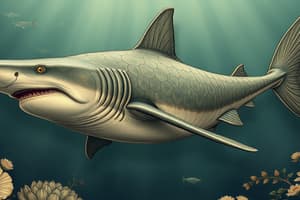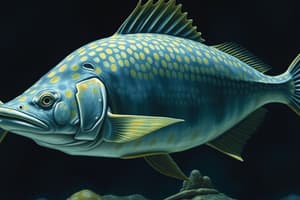Podcast
Questions and Answers
What is the primary function of the swim bladder in bony fishes?
What is the primary function of the swim bladder in bony fishes?
- To provide protection against predators
- To regulate buoyancy (correct)
- To enhance feeding efficiency
- To aid in locomotion
Which part of a turtle's shell is located on the dorsal side?
Which part of a turtle's shell is located on the dorsal side?
- Plastron
- Carapace (correct)
- Scales
- Fins
How do scales benefit bony fishes?
How do scales benefit bony fishes?
- They assist in thermoregulation
- They help in buoyancy regulation
- They provide energy for swimming
- They offer protection and reduce water resistance (correct)
What are the two main parts of a turtle's shell called?
What are the two main parts of a turtle's shell called?
Which fin is primarily responsible for swimming and steering in fish?
Which fin is primarily responsible for swimming and steering in fish?
What primary function does the internal line system of Chondrichthyes serve?
What primary function does the internal line system of Chondrichthyes serve?
How do cartilaginous fishes primarily maintain buoyancy?
How do cartilaginous fishes primarily maintain buoyancy?
Which structure is unique to cartilaginous fishes compared to bony fishes?
Which structure is unique to cartilaginous fishes compared to bony fishes?
What is the purpose of the caudal fin in cartilaginous fishes?
What is the purpose of the caudal fin in cartilaginous fishes?
What structural feature aids in the stabilization of cartilaginous fishes during swimming?
What structural feature aids in the stabilization of cartilaginous fishes during swimming?
How do cartilaginous fishes differ from bony fishes in terms of their skeletal structure?
How do cartilaginous fishes differ from bony fishes in terms of their skeletal structure?
What role do nostrils play in cartilaginous fishes?
What role do nostrils play in cartilaginous fishes?
What is the function of the cloaca in cartilaginous fishes?
What is the function of the cloaca in cartilaginous fishes?
Flashcards
What is the function of the operculum?
What is the function of the operculum?
A bony flap that covers and protects the gills in fish.
What is the swim bladder?
What is the swim bladder?
A gas-filled sac that helps fish regulate their buoyancy.
What are scales?
What are scales?
Bony plates covering the fish's skin, providing protection and reducing water resistance.
What is the carapace?
What is the carapace?
Signup and view all the flashcards
What is the plastron?
What is the plastron?
Signup and view all the flashcards
Lateral Line System
Lateral Line System
Signup and view all the flashcards
Buoyancy
Buoyancy
Signup and view all the flashcards
Buoyancy in Cartilaginous Fishes
Buoyancy in Cartilaginous Fishes
Signup and view all the flashcards
Cartilage
Cartilage
Signup and view all the flashcards
Placoid Scales
Placoid Scales
Signup and view all the flashcards
Gill Slits
Gill Slits
Signup and view all the flashcards
Cloaca
Cloaca
Signup and view all the flashcards
Bone
Bone
Signup and view all the flashcards
Study Notes
Chondrichthyes (Cartilaginous Fishes)
-
Internal Line System: A series of sensory receptors along the body detects water pressure, movement, and vibrations. This aids in navigation, hunting, and predator avoidance.
-
Buoyancy: Lack a swim bladder. Instead, rely on large, oily livers for neutral buoyancy and constant swimming for lift.
-
External Anatomy:
- Skeleton: Cartilaginous, lighter and more flexible than bone.
- Scales: Placoid scales (tooth-like) reduce drag and offer protection.
- Respiration: Multiple gill slits on each side of the head.
- Mouth: Located on the underside, often with sharp teeth.
- Senses: Two pairs of nostrils for smell; well-developed eyes for sight.
-
Fins: Various fins for swimming, maneuvering, and balance:
- Dorsal fins for stability.
- Caudal fin for propulsion.
- Pectoral fins for steering and braking.
- Pelvic fins for balance and reproduction.
-
Cloaca: Single opening for digestive, urinary, and reproductive tracts, near the tail base.
Osteichthyes (Bony Fishes)
-
External Anatomy:
- Skeleton: Bony, stronger and more supportive than cartilage.
- Operculum: Bony flap protecting gills.
- Swim Bladder: Gas-filled sac to regulate buoyancy.
- Scales: Bony scales offer protection and reduce drag.
- Fins: For swimming, steering, and balance (Dorsal, Caudal, Pectoral, Pelvic).
-
Swim Bladder: A gas-filled sac that helps maintain buoyancy by controlling the amount of gas in the bladder.
Turtle Shells (in Turtles and Tortoises)
- Carapace and Plastron: Bony structures forming the shell.
- Carapace: Dorsal (upper) part of the shell.
- Plastron: Ventral (lower) part of the shell.
- These structures provide protection for vital organs and regulate body temperature.
Studying That Suits You
Use AI to generate personalized quizzes and flashcards to suit your learning preferences.
Description
This quiz explores the anatomy and physiology of Chondrichthyes, including their internal line system, buoyancy adaptations, and unique characteristics. Discover how these fascinating creatures navigate their environment and their specialized structures for survival in aquatic habitats.



